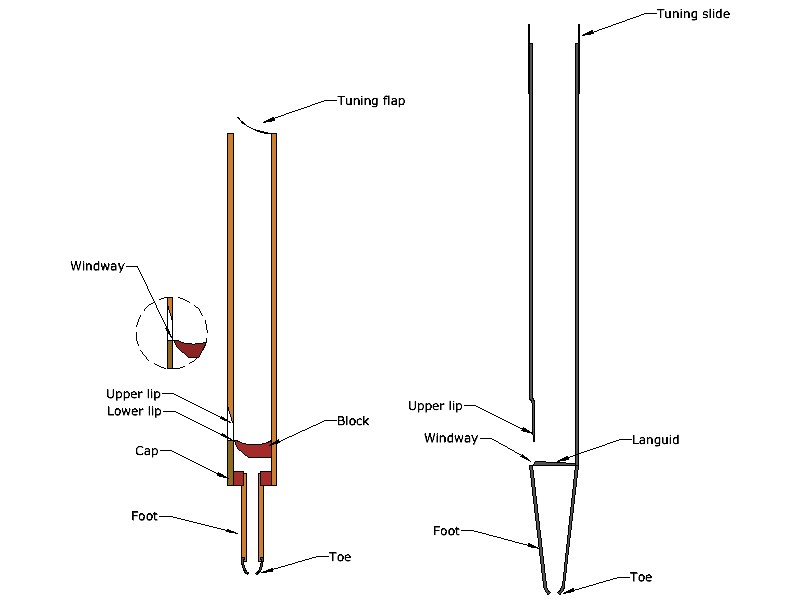The basic principle of the open flue pipe is the same as the orchestral flute, recorder and penny whistle, where a sharp edge is located at one end of an open-ended tube which forms the body of the instrument.
To make sounds, a stream of air is blown over the sharp edge; aerodynamic effects cause the stream to flutter rapidly from one side of the sharp edge to the other; this fluttering in turn causes the column of air in the body of the instrument to vibrate at a frequency which gives a note of a certain pitch.
In an organ flue pipe, the sharp edge is known as the upper lip. The stream of air (‘windsheet’) is formed by air blowing into the foot of the pipe and then escaping upwards through the windway, which is a narrow slit formed by the gap between the languid and the lower lip. The windsheet strikes the upper lip and, by fluttering to and fro creates sound. The vertical gap between the languid and the upper lip is referred to as the mouth.
The pitch of the sound produced depends on the speaking length of the pipe; this is adjusted (for tuning purposes) by a springy metal collar known as a tuning slide. This can be knocked upwards to lengthen the pipe (making the note lower) or downwards to shorten the pipe (making the note higher). String pipes, instead of having a tuning slide overlapping the end of the pipe, may have a slot slightly below the end of the pipe which is partially covered by a tuning slide. Wooden pipes are usually tuned by means of a flap of pipe-metal attached over the top of the pipe, or by a slot with a moveable wooden cover. Old organs may have the pipes cut to the exact length and then be finely tuned by the use of a cone to bell outwards (sharpen) or cone inwards (flatten) the top of the pipe; this method can however lead to significant damage to the pipe over a long period.
A number of different parameters affect the sound produced by a pipe; these parameters interact with each other and are unlikely to be varied in isolation. This combination of parameters gives the pipework from a particular builder its characteristic sound. They include:
Wind pressure. The basic effect of increasing the wind pressure is to increase the harmonics produced by the pipe. This is counteracted by specific voicing and design techniques, including increase of cut-up (see below) and leathering of the upper lip. These techniques are often employed on theatre organ Tibia and Diaphonic Diapason pipework.
Scale. The ratio between the diameter (or width) and the speaking length of the pipe. Narrow scale pipes produce string-like tones with more harmonics, and wide scale pipes flute-like tones with fewer harmonics. Although scale is properly defined as a ratio, most builders specify scale as the diameter or width measurement of the lowest pipe of a stop.
Mouth Width. The ratio between the width of the mouth and the circumference of the pipe. Generally, pipes with wider mouths sound louder. An extreme example is the Doppel Flute which has two mouths, one on the front and one on the back.
Cut-up. The height of the upper lip above the languid; this is often greater on higher pressure pipework where relatively few upper harmonics are required.
Languid. The front of the languid is often ‘nicked’, by means of a knife or file, in order to change the speaking characteristics of the pipe, especially the promptness of speech. The languid may also be depressed or raised relative to the lower lip in order to modify the speaking characteristics.
Toe hole. Air reaches the pipe via the windchest; the diameter of the toe hole may be reduced to quieten the pipe or increased – to the point where it is as big as the boring in the windchest toe board – in order to louden the pipe. Toe hole also affects the promptness and liveliness of speech. On the larger theatre organ ranks, especially the Tibia, it also affects the degree to which the pipe is affected by the tremulant; some organ technicians like to increase the toe hole diameter and then reduce the pipe wind pressure in order to increase the tremulant effect without making the stop over-bearing.
A number of other features may be noted on theatre organ pipework:
Leathered upper lip. As mentioned above, on higher pressure stops the upper lip maybe leathered to produce a smoother, rounder tone from the pipe. This may be at the expense of clarity and promptness of speech.
Bridge. On string and narrower scale diapason pipes, a roller bridge ( a length of wood dowel or metal tube/rod) may be placed horizontally across the mouth of the pipe in order to promote stability of speech.
Ears. Vertical strips either side of the mouth also promote stability of tone, especially on string and diapason pipes.

